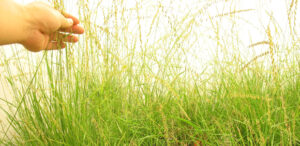Exceptional Forages for Marginal Lands
This article written by Dr. Reynold Bergen, BCRC Science Director, originally appeared in the April 2019 issue of Canadian Cattlemen magazine and is reprinted on the BCRC Blog with permission of the publisher.

Tame forages often outperform native species in head-to-head comparisons under optimal growing conditions. This may not be the case on “marginal land,” with its tougher environments, poorer soil, rougher topography, harsher climates, and precipitation extremes. Beef production is expected to rely more and more on marginal land, at least while returns from cash crops exceed those from cow-calf production.
Beef Cluster research led by Mike Schellenberg (Agriculture and Agri-Food Canada Swift Current), Eric Lamb (University of Saskatchewan) and a team of graduate students has been examining Western Canadian native plants since 2009. Some results from this study were published in 2018 (“Mixtures of native perennial forage species produce higher yields than monocultures in a long-term study”; Canadian Journal of Plant Science 98:633-647).
What They Did:
Small (4 x 8 m) plots of five native grasses (bluebunch wheatgrass, nodding brome, western wheatgrass, little bluestem and side oats gramma) and two legumes (purple prairie clover and white prairie clover) were seeded at AAFC Swift Current in 2010. Each grass or clover was seeded on its own (7 monocultures), as well as with each of the other grasses and legumes (21 binary mixtures). No fertilizers or herbicides were used. From 2011 through 2016, the plots were clipped at ground level in early July and late August and assessed for yield, crude protein, and fiber (acid detergent fiber and neutral detergent fiber) levels. Total digestible nutrients and energy content were not calculated.
What They Learned:
In terms of yield, western wheatgrass out-performed the other individual grasses by 43% (compared to bluebunch wheatgrass) to 323% (side oats gramma) when results were averaged across all years. Grass mixtures generally out-yielded grass monocultures by 8% (bluebunch wheatgrass grown in mixtures vs. bluebunch wheatgrass grown on its own) to 61% (side oats gramma grown in mixtures compared to side oats gramma grown on its own). Grass mixtures that contained western wheatgrass out-yielded all of the other grass mixtures.
Both legumes had lower yields than any of the grasses. Adding a native legume to a native grass usually didn’t improve yields. The exception was western wheatgrass, which yielded 8% more when it was combined with purple prairie clover compared to when western wheatgrass was grown with other grasses.
Crude Protein: The two clovers averaged 11.8 to 12% crude protein across all years, twice as much as any of the grasses (4.7 to 6%). Western wheatgrass (and mixes containing it) contained slightly more crude protein (6.1%) than the other grasses or mixes (4.7 to 5.5%).
Mixing white or purple prairie clover with a grass increased average crude protein levels to 6.8%. Average crude protein levels were somewhat higher when clover was added to nodding brome (7.6%) or side oats gramma (7.2%). Mixtures of clovers with western wheatgrass were intermediate (6.8%), and mixtures of clovers with bluebunch wheatgrass (6.3%) or little bluestem (6.2%) had the lowest crude protein levels.
Fiber: Among individual grasses, acid detergent fiber levels were lower (so digestibility was higher) for side oats gramma (33%) and western wheatgrass (34%) than the other grasses (37 to 40%). Neutral detergent fiber was lower (meaning cattle intake would likely be higher) for bluebunch wheatgrass (61.7%) and western wheatgrass (61.9%) than for side oats gramma (63.7%), nodding brome (65.0%) or little bluestem (68.3%). The native clovers had lower levels of acid (30%) and neutral detergent fiber (40%) than any of the grasses.
What it Means:
This study used lab analyses of clipped samples rather than animal performance because 4m x 8m plots are obviously too small to graze. Native pastures also aren’t typically managed by grazing to ground level, and grazing preferences for some plants over others may lead to changes in species composition that would not be observed in a clipping study.
When the yield, crude protein, and acid and neutral detergent fiber results were averaged over the whole study, western wheatgrass (and the mixtures containing it) likely appears to be the most promising choice. But year-to-year variations can be especially important in marginal lands. For example, bluebunch / clover mixtures out-yielded the other grass / clover mixes in 2015 (a very dry year). In 2016 (the fourth wettest year on record), grass mixes containing little bluestem mixes out-yielded the other grass mixes. More complex forage mixtures are likely better able to cope with year-to-year variations in growing conditions than single species monocultures. This team is currently conducting long-term work looking at more complex 7- and 14-species mixtures under grazing conditions.
The Productivity pillar of Canada’s National Beef Strategy aims to increase production efficiencies by 15%. One outcome of this pillar is to increase the yields and nutritional quality of tame and native annual and perennial forages through improved pasture, hay and grazing management, plant breeding and variety selection recommendations. The Strategy explains why the Canadian Beef Cattle Check-Off increased from $1 to $2.50 per head in most provinces (with approximately 75 cents allocated to the Beef Cattle Research Council), and how it is being invested.
The Beef Research Cluster is funded by the Canadian Beef Cattle Check-Off and Agriculture and Agri-Food Canada with additional contributions from provincial beef industry groups and governments to advance research and technology transfer supporting the Canadian beef industry’s vision to be recognized as a preferred supplier of healthy, high quality beef, cattle and genetics.
Click here to subscribe to the BCRC Blog and receive email notifications when new content is posted.
The sharing or reprinting of BCRC Blog articles is typically welcome and encouraged, however this article requires permission of the original publisher.
We welcome your questions, comments and suggestions. Contact us directly or generate public discussion by posting your thoughts below.